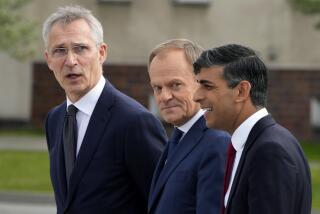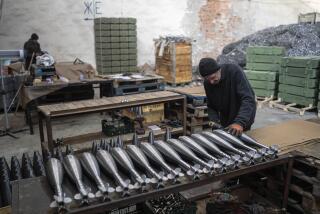Trump proposes huge increase in military spending

The Trump administration on Monday proposed a defense budget of $716 billion for fiscal 2019, part of an ambitious effort to substantially boost Pentagon spending after years of tight budget limits and refocus the military on countering Russia and China.
The budget blueprint, combined with a defense boost that Congress approved last week, would increase Pentagon accounts for weapons, troops, training and for nuclear arms programs run by the Energy Department by more than $74 billion, a 10% increase over current spending levels.
The budget “is what we need to bring us back to a position of primacy,” Defense Secretary James N. Mattis told reporters on a flight to Rome late Sunday, citing plans to buy more F-18 fighters, train more Air Force mechanics, and create new cyberwarfare units as examples of how the money will be spent.
Trump’s budget plan was released weeks after the Pentagon issued a national security strategy that called for a shift away from battling terrorist groups, such as Al Qaeda and Islamic State, and retooling the military to deter and, if necessary, fight nuclear-armed adversaries such as Russia, China or North Korea.
Though President Trump has frequently called for improving relations with Moscow and enlisting Beijing to put diplomatic pressure on North Korea, Pentagon officials are far more explicit about what they claim is a growing threat from Russia and China to U.S. allies in Europe and Asia.
“It is increasingly apparent that China and Russia want to shape a world consistent with their authoritarian values,” Undersecretary of Defense David L. Norquist said Monday at a Pentagon news briefing. “We recognize that, if unaddressed, our eroding U.S. military advantage versus China and Russia could undermine our ability to deter aggression and coercion in key strategic regions.”
The call for a substantial increase in defense spending also comes months after two Navy guided-missile destroyers collided with civilian cargo ships in the western Pacific, killing 17 sailors. The accidents galvanized concerns by lawmakers and at the top levels of the Pentagon that congressional-mandated spending caps since 2011 had harmed readiness and training in the armed services.
Pentagon officials long have complained that the spending caps had left some combat units unprepared to fight and had delayed maintenance on crucial equipment while the military was still engaged in conflicts around the globe.
With the spending caps lifted at least for the next two years, most major Pentagon accounts would receive budget increases. The money would go for more training, more interceptors for ballistic missile defense, new missile-carrying submarines, a planned new bomber, and modernization of aging nuclear warheads.
The increase in defense spending that lawmakers approved last week went beyond what the White House had initially sought — $603 billion for the base Pentagon budget, with another $65 billion for war-related costs.
“It’s a big jump for fiscal 2018 and fiscal 2019 compared to where we are,’” said Todd Harrison, a defense budget specialist at the Center for Strategic and International Studies, a nonpartisan think tank.
In broad terms, the new budget proposal recommends $617 billion for the base Pentagon budget and $69 billion more for the wars in Iraq, Syria, Afghanistan and other ongoing military operations.
Another $30 billion would go to the National Nuclear Security Administration, the Energy Department agency that oversees nuclear weapons research. That’s an increase of $1.69 billion for weapons activities, including upgrading and building new nuclear warheads.
Trump’s proposal now goes to Congress, which is likely to adjust some specifics. The overall spending levels were worked out, however, in an ambitious two-year budget deal reached last Friday with congressional leaders from both parties.
Among the most expensive proposals would increase the size of the active-duty armed forces by 25,900 by next year and by 56,600 by 2023.
The active-duty Army would expand the most, going from a 2018 authorized level of 476,000 to 495,500 over the next six years. By 2023, the Navy would increase by 16,900, the Marine Corps by 1,400, and the Air Force by 13,700, increasing the active-duty military to 1,365,500.
The number of Air Force combat squadrons would increase from 55 to 58 by 2023.
Personnel increases are costly because they include benefits and salary, as well as the costs of training and equipping new service members. Even those increases do not restore the military to the force it was at the height of the Iraq war in 2009, when total active-duty strength was 1.4 million.
Despite the spending hike, the increase is not likely to relieve pressure on many parts of the armed forces anytime soon, Harrison said.
It takes years to recruit and train new forces, and although Pentagon officials want to refocus on preparing for war against other major powers, U.S. forces are still deployed in substantial numbers in Afghanistan, Iraq and other hot spots fighting insurgents and other unconventional foes.
“Our forces are overstretched because of the current operational tempo, and it’s not a budget issue. It’s a strategy issue,” Harrison said. “That’s something the [Defense] department hasn’t really grappled with.”
Missile-defense batteries at Ft. Greely, Alaska, and at Vandenberg Air Force Base in Santa Barbara County would gain up to 44 more interceptor missiles, a move that comes in response to North Korea’s development of ballistic missiles with the range to strike the continental United States.
The Pentagon would spend $48.9 billion in Afghanistan, nearly $2 billion more than last year, while the fight against Islamic State in Iraq and Syrian would receive $15.3 billion, an increase of $2.3 billion over last year.
The proposal also includes $6.5 billion to place more tanks, armored vehicles and other combat equipment in Europe, part of a Pentagon plan to reassure allies nervous about Russian military aggressiveness in central Europe.
Trump has asked the Pentagon to develop options for a major military parade in Washington this year, similar to one he watched last year in Paris that included French tanks, missiles and troops. The administration budget proposal does not clearly set aside money for moving those forces to the capital.
Twitter: @davidcloudLAT
More to Read
Start your day right
Sign up for Essential California for news, features and recommendations from the L.A. Times and beyond in your inbox six days a week.
You may occasionally receive promotional content from the Los Angeles Times.







